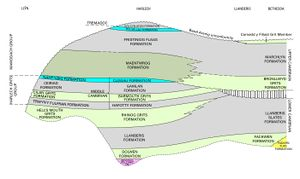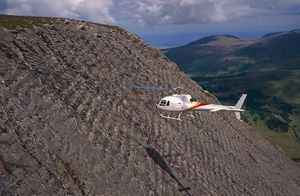Comley Series, Cambrian, Wales
From: Howells, M F. 2007. British regional geology: Wales. Keyworth, Nottingham: British Geological Survey.








In Arfon, Comley Series (Lower Cambrian) strata overlie the Padarn Tuff Formation in the outcrop between Deiniolen and Penygroes, where they comprise the Fachwen Formation (P916150), and in the vicinity of Bangor, where they form the Minffordd and Bangor formations. The contact near Fachwen on the north side of Llyn Padarn was considered to be the Precambrian-Cambrian boundary in the 19th century. The lower formations thicken dramatically from some 50 m on the east side of Llyn Padarn, to about 500 m on the west side and to 2000 m near Bangor; this increase is thought to reflect rapid subsidence associated with intense tectonic activity. The lowermost beds, conglomerates and sandstones, overlie Precambrian welded ash-flow tuffs (Padarn Tuff Formation), and locally thin beds of fine- grained air-fall tuff and ash-flow tuff indicate that volcanism recurred sporadically in the vicinity. The conglomerates, consisting mainly of subangular clasts of welded tuff, and the sandstones with distinctive quartz crystals derived from the underlying tuffs, probably represent rapidly accumulating alluvial fan and fluvial deposits, composed of debris derived from local fault scarps and fluvial systems. Well-rounded clasts of quartzite, mica-schist, granite and jasper indicate more distant derivation from the Precambrian on Anglesey. Towards the top of the sequence, the increasing frequency of silty mudstone interbeds suggest more general subsidence with the establishment of a more extensive marine basin in which mudstone of the overlying Llanberis Slates Formation was deposited.
The Llanberis Slates Formation is the source of the slates that have been worked in the vicinity of Bethesda, Llanberis and Nantlle for over 200 years and accounted for the growth of these communities. The distribution of the formation at outcrop is clearly defined by the numerous trials and small quarries that were excavated beyond the main quarries at Penrhyn and Dinorwic (P662392), (P662393). The formation consists mainly of blue-grey and purple silty mudstone, which accumulated in a broad marine basin that deepened to the south-east. Intermittent instability in the vicinity of the distant shoreline, probably to the north-west, caused incursions of coarse sands in turbidity flows, which locally fill channels in the underlying mudstones and include distinctive rip-up clasts of silty mudstone. These coarse-grained sandstones formed major obstructions to slate extraction and were given local names by the quarrymen; for example, the Dorothea Grit at Nantlle was considered to be the equivalent of Red Grit (Gwenithfaen-Goch) at Penrhyn, but such correlations are difficult to substantiate.
Bedding in the purple silty mudstone is locally well developed, commonly accentuated by sharply contrasting green bands as a result of the reduction of iron; similar reduction produced the characteristic green spotting, which has been used to estimate strain across the slate belt. Large fresh surfaces of slate produced by modern cutting equipment commonly reveal a spectrum of bedding fabrics, from slump folds in continuous beds of silty mudstone and muddy siltstone, to totally disaggregated sediment. The latter probably produce the best slates because they contain no well-defined bedding planes or other lithological contrasts to interrupt the cleavage. Trilobites found in green slates near the top of the formation in Penrhyn Quarry include Pseudatops viola, and they provide the lowest biostratigraphical evidence in the sequence. The fauna has been assigned to the top of the Olenellid Zone, in the middle of the Comley Series. Estimation of the thickness of the Llanberis Slates Formation is difficult because it lies between two more competent formations, and consequently channelled a great deal of the strain when the sequence was folded. However, a minimum of 380 m has been indicated on the published maps.
These lithological subdivisions of the Comley sequence can be traced southwards from Bethesda to Nantlle with some confidence. However, farther to the south, into the Harlech Dome, correlation is more difficult. Here, the lowest part of the sequence comprises pebbly, cross- bedded sandstone with interbedded siltstone and mudstone (Dolwen Formation); the base is not exposed but it was proved in a borehole, overlying the Brynteg Volcanic Formation of probable Precambrian age. The base is defined by conglomeratic volcaniclastic sandstones, although the contained clasts are compositionally different from the underlying strata. The overlying sequence of interbedded sandstone and siltstone indicates several phases of delta building, and an overall gradual progression into deeper water settings. The only body fossil is a specimen of Platysolenites antiquissimus, of Comley age, recovered from the Brynteg Borehole. At the top of the sequence, laminae with euhedral feldspar crystals and fragments of quartz euhedra have been intepreted as air-fall tuffs although the site of the vent has not been determined.
The lower sandstone sequence grades up into blue and purple silty mudstone (Llanbedr Formation), which has been worked for slates at a number of localities near Harlech. The overlying Rhinog Grits Formation, up to 780 m thick, forms the castellate ridges of Rhinog Fawr, Rhinog Fach and Y Llethr that dominate the local topography (P662394). The formation is characterised by massive, locally pebbly, graded turbiditic sandstone and mudstone, thin flaggy, fine-grained sandstone interbeds and beds of well-sorted, coarse-grained sandstone. Many of the pebbles are of lithologies similar to Anglesey Precambrian rocks. The formation is spectacularly exposed about the Roman Steps, in Cwm Bychan (P662395). The dominance of the turbiditic process in the accumulation of this sequence was first demonstrated in the classic studies by Kuenen in 1953 and Kopstein in 1954. Elements of the Bouma cycle are present throughout various combinations and in the sole marks and current bedding indicate deposition in a submarine fan complex, with sediment transport mainly from the north-east.
Similar coarse sandstones forming the Hell’s Mouth Formation, crop out on the west side of St Tudwal’s peninsula on Llŷn, although their base is not seen (P916151). The beds are crudely graded, with cross-laminations, convolute bedding and groove and flute casts which are commonly loaded. In most of the formation only trace fossils are present, but trilobites (Hamatolenus (Myopsolenus) douglasi, Kerberodiscus succinctus and Serrodiscus ctenoa?) associated with hexactinellid sponge spicules and a single inarticulate brachiopod near the top indicate the upper part of the Protolenid-Strenuellid Zone of the Comley Series (Table 2), which is younger than the Pseudatops viola horizon at the top of the Llanberis Slates Formation. However, the broad correlation suggests that the latter developed distally to the fan complex of the Rhinog Grits Formation at the end of Comley Series times.
In Pembrokeshire, the Comley Series (P916152) is up to 300 m thick and is represented by the Caerfai Group, which outcrops in both the St David’s and Hayscastle anticlines. A basal conglomerate, which contains pebbles of quartz, quartzite and acid tuff, displays channel structures and large-scale planar cross-stratification, with the foresets directed southwards. These structures, together with the occurrence of vertical cylindrical burrows of Skolithus, have been interpreted as indicating intertidal deposits. The conglomerates are overlain by green feldspathic sandstone (St Non’s Sandstone) with detrital blue amphibole, red mudstone (Caerfai Bay Shales), and plane and cross-laminated, micaceous, feldspathic, purple sandstone (Caerbwdy Sandstone) (P662396). The red mudstone forms a convenient marker and is conspicuous in the cliffs at Caerfai, at Castell on Ramsey Sound and at Cwm Mawr near Newgale. Pale tuffs interbedded with the red mudstone have given a radiometric age of 519 ± 1 Ma. The mudstone is the lowest unit from which fossils, although rare, have been recorded. These include Lingulella primaeva and the bradoriid Indiana lentiformis of probable late Comley age. The sequence west of St David’s reflects a nearshore shelf environment, but the lack of symmetrical wave ripples suggests that deposition occurred below wave base (100 to 200 m).
At Llangynog, south-west of Carmarthen, a thin conglomerate and green feldspathic sandstones, the former containing well-rounded pebbles of igneous rocks, overlies the Precambrian rhyolites and volcaniclastic sedimentary rocks and are considered to be of Comley age.
Bibliography
GIBBONS, W, and HARRIS, A L (editors). 1994. A revised correlation of Precambrian rocks in the British Isles. Geological Society of London Special Report, No. 22.
In addition
BEVINS, R E, PHARAOH, T C, COPE, J C W, and BREWER, T S. 1995. Geochemical characters of Neoproterozoic volcanic rocks in southwest Wales. Geological Magazine, Vol. 132, 339–349.
BOUMA, A H. 1962. Sedimentology of some flysch deposits. (Amsterdam: Elsevier.)
COLLINS, A S, and BUCHAN, C. 2004. Provenance and age constraints of the South Stack Group, Anglesey, UK: U-PB SIMS detrital zircon data. Journal of the Geological Society of London, Vol. 161, 743–746.
COPE, J C W, INGHAM, J K, and RAWSON, P F. 1992. Atlas of palaeogeography and litho-facies. (London: The Geological Society.)
CRIMES, T P. 1970. A facies analysis of the Cambrian of Wales. Palaeogeography, Palaeoclimatology, Palaeoecology, Vol. 7, 113–170.
GIBBONS, W, and HORAK, J M, 1990. Contrasting metamorphic terranes in north-west Wales. 315–328 in The Cadomian Orogeny. D’LEMOS, R S, STRACHAN, R A, and TOPLEY, C G (editors). Geological Society of London Special Publication, No. 51.
GIBBONS, W, and MCCARROLL, D. 1993. Geology of the country around Aberdaron, including Bardsey Island. Memoir of the British Geological Survey, Sheet 133 (England and Wales).
GIBBONS, W, TIETZSCH-TYLER, D, HORAK, J M, and MURPHY, F C. 1994. Chapter 9 Precambrian rocks in Anglesey, south-west Llŷn and south-east Ireland. 75–84 in A revised correlation of Precambrian rocks in the British Isles. GIBBONS, W, and HARRIS, A L (editors). Geological Society of London Special Report, No. 22.
HICKS, H. 1877. On the Precambrian (Dimentian and Pebidian) rocks of St David’s. Quarterly Journal of the Geological Society of London, Vol. 33, 299–241.
HICKS, H. 1884. On the Precambrian rocks of Pembrokeshire with special reference to the St David’s district. Quarterly Journal of the Geological Society of London, Vol. 40, 507–547.
KUENEN, PH H. 1953. Graded bedding with observations on Lower Palaeozoic rocks of Britain. Verh. K. Nederland, Akad Wet Afd Nat (B) 20 (3).
KOPSTEIN, F P H. 1954. Graded bedding of the Harlech Dome. Diss Groningen Rijksuniv, 1–97.
PHILLIPS, E. 1991. The progressive deformation of the South Stack and New Harbour groups, Holy Island, western Anglesey, north Wales. Journal of the Geological Society of London, Vol. 148, 1091–1100.
PHILLIPS, E. 1991. The lithostratigraphy, sedimentology and tectonic setting of the Monian Supergroup, western Anglesey, north Wales. Journal of the Geological Society of London, Vol. 148, 1079–1090.
RUSHTON, A W A. 1974. The Cambrian of Wales and England. 43–120 in Cambrian of the British Isles, Norden and Spitzbergen. HOLLAND, C H (editor). (London: John Wiley.)
RUSHTON, A W A, and HOWELLS, M F. 1999. Stratigraphical framework for the Ordovician of Snowdonia and the Lleyn peninsula. British Geological Survey Research Report, RR/99/08.
TIETZSCH-TYLER, D. 1996. Precambrian and early Caledonian Orogeny in south-east Ireland. Irish Journal of Earth Sciences, Vol. 15, 19–39.